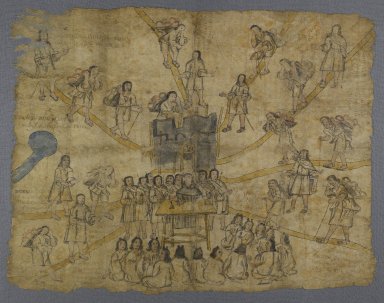
Artist:Nahuatl
Medium: Ink and watercolor on amate paper
Geograhical Locations:
Dates:18th century
Dimensions: 30 5/8 x 38 5/16 in. (77.8 x 97.3 cm)
Collections:
Exhibitions:
Accession Number: 41.1249
Image: 41.1249_PS2.jpg,
Catalogue Description: Pictorial document on one single, large sheet of amate paper (composed of about 17 pieces that have been adhered together). There are 12 Nahuatl inscriptions in light black ink, oriented in various directions. The place name San Pedro Atlapolco occurs several times, which is why the document is believed to have originated in that community, and to record the foundation of its church. The drawing of ink and watercolor depicts a church under construction in the center of the community. Native men dressed in loose tunics, belted at the waist, carry loads of construction materials toward the building site. In front of the building, a friar is seated at a table with a pen and several pages of writing. Behind him, native nobles gesture in support, and in front native women kneel and form the audience. This document is part of the Techialoyan corpus, a group of pictorial documents produced by and for native communities in the State and Valley of Mexico, in the 18th century (see Diana Fane, ed., Converging Cultures: Art and Identity in Spanish America, New York: Brooklyn Museum in association with Harry N. Abrams, Inc. Publishers, 1996, p. 82-3).